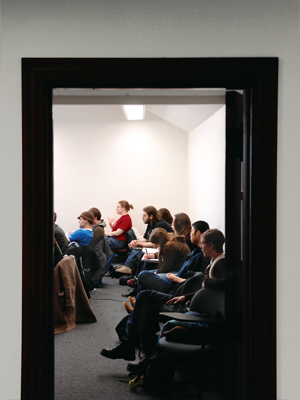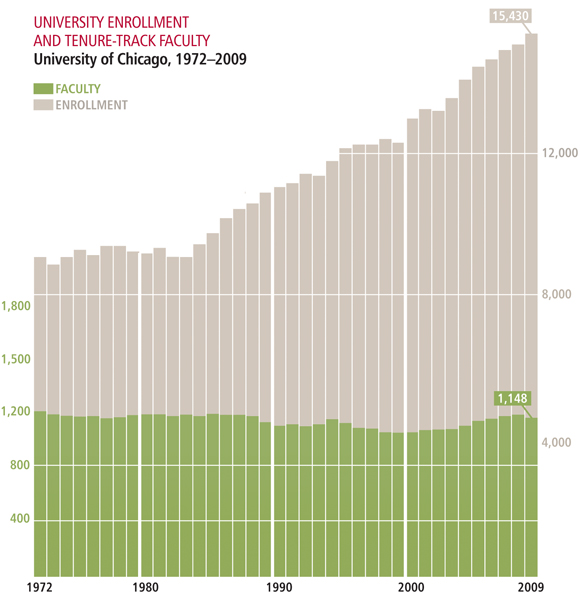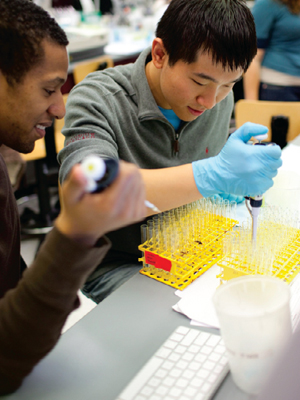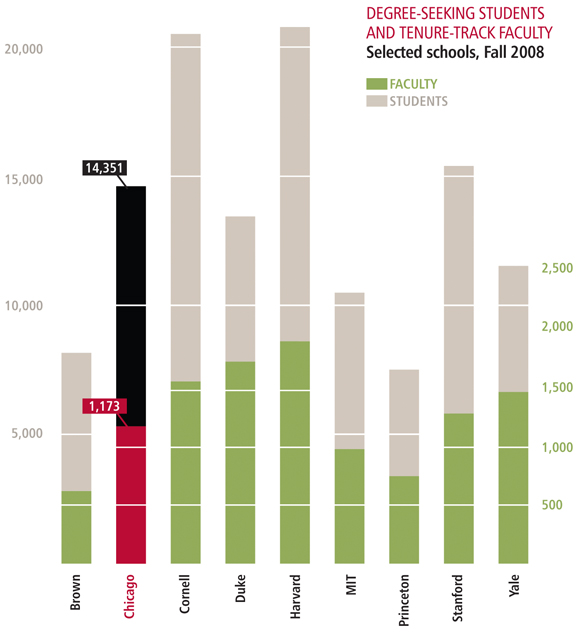Opportunity knocks
With the doors open to new investments, the University plans its first faculty expansion in four decades.
By Elizabeth Station
Photography by Dan Dry
During the first week of classes last September, Agnes Callard, AB’97, a new assistant professor in philosophy, went to her office hours in Stuart Hall for the first time. She thought she might steal a little quiet time. After all, only one of her two classes—ancient philosophy and Human Being and Citizen—had even met.

To her surprise, seven students stopped by, and more kept coming. “My office hours were always packed with students, every week,” says Callard. “They see the problems that we talk about in class—they see getting Plato right—as a matter of life and death.” That intensity was appealing and part of why Callard returned to Chicago after earning a PhD at the University of California, Berkeley. But it also was a little daunting: between teaching, research, and departmental work, she admits that sometimes she “didn’t have room to breathe.”
Faculty members are similarly stretched in departments across the University, but especially in those that serve large numbers of undergraduates: economics, English, math, political science. Both novice and veteran professors balance the same set of tasks: they teach classes, advise students, push their own scholarship forward, attend committee meetings and workshops, and stay current in their own and related disciplines.
Such competing demands aren’t novel, but at Chicago the terrain has shifted. Since the early 1970s, the size of the tenure-track faculty—at 1,148 in fall 2009—has remained relatively constant. Meanwhile, enrollment in the College, graduate, and professional programs has climbed from roughly 9,000 to more than 15,000 students (see chart, page 33). Academic fields have evolved and, with them, entirely new areas of knowledge. From the humanities to the sciences there are departments, degree programs, and interdisciplinary centers that didn’t exist 20 years ago. Providing intellectual leadership for those efforts and ensuring top-quality teaching and research require increased attention and time. Those close to the problem say the solution is to hire more professors to do the work.
Responding to the need and taking advantage of market opportunities, the University has launched its first systematic faculty expansion in four decades. In late June, after reviewing 51 faculty proposals, Provost Thomas F. Rosenbaum and a group of deans authorized the creation of 22 new assistant professorships in the humanities, social and physical sciences, and Divinity School. Over the next four years, faculty will be hired not only in traditional fields like ethics and macroeconomics, but also in emerging areas like planetary formation and evolution, social neuroscience, and new media.
While searches for those scholars unfold, eight additional positions will be added in law, social service administration, and public policy. Chicago also hopes to attract ten distinguished senior scholars, across the institution, as new “University professors.” In all, by 2014 the University expects to create 40 new positions, bringing the total number of tenure-track faculty close to 1,200. “We hope to continue to build the faculty at a steady-state rate of 1 percent a year after this initial phase,” says Rosenbaum. Using that marker, about a dozen professorships would be added annually from 2015 to 2020.
In difficult economic times, faculty and administrators say, investing in human capital is ambitious and necessary. “The essence of the University of Chicago’s ability to compete with often better-endowed peers is the ability to attract the most innovative and original scholars to our campus,” Rosenbaum argues. “This initiative will bring bright, young people with new approaches and energy to burn, as well as established stars at the most senior level.” The motives and strategies for getting those scholars here reflect the University’s particular needs, ambitions, and culture—as well as the current environment in higher education.

The setting for Katherine Kinzler's early-morning core course is Kent 174. In the large, tiered classroom, about 100 somewhat sleepy students have gathered to listen, some taking notes, as the assistant professor of psychology works her way through a PowerPoint-style presentation on social learning in infants.
Kinzler, who coteaches Mind III with seven other instructors, is a poised and lively presenter. Still, the laser pointer has replaced Socratic dialogue, which will happen later, in small weekly discussion sections. Other in-demand courses are also taught in lecture format, says John Mark Hansen, dean of the social-sciences division. “We have some departments where the enrollments and courses have gotten to be very, very large,” he says. “It affects the experience that students have, and it affects the variety of curricular offerings that departments are able to make.”

It’s especially true in the social sciences, where half of all College students choose majors. Political science, history, and international studies are popular choices. Economics—the top undergraduate major—draws about 250 students from each class year, up from about 150 in 1995. The econ curriculum has become more math intensive, yet the tenure-track economics and math faculties haven’t grown to meet demand. “Over the past 25 years, our departments have remained pretty much the size that they were back in the 1960s, when, in many fields, the peer departments at other institutions have gotten larger,” says Hansen. Harvard, for example, awards the same number of undergraduate economics degrees as Chicago every year, but has 56 tenure-track economics faculty compared to the University’s 25.
At Chicago and elsewhere, part-time instructors and lecturers with PhDs shoulder some of the responsibility for teaching. Harper-Schmidt fellows, who receive three- or four-year appointments to teach in the College, also help to maintain student-faculty ratios and the quality of instruction. Yet University-wide, the expectation is that tenure-track faculty will teach the majority of Common Core, graduate, and undergraduate courses—even as the student body has grown. Having seasoned scholars lead small, seminar-style discussions “is our tradition. It’s what we’ve always stood for,” says historian John W. Boyer, AM’69, PhD’75, dean of the College. “From our perspective, that’s really driven the need for an increase in faculty.”
The University's first president, William Rainey Harper, fervently believed that faculty must be active teachers and first-rate scholars—not one or the other. Harper also thought Chicago’s faculty should be lured from the best institutions in the world to create a university that was, in his words, “‘bran splinter new,’ yet as solid as the ancient hills.” Undoubtedly, the need for classroom teachers has spurred the University’s latest move to invest in faculty. But there is equal excitement about what the infusion of up-and-coming talent might mean for research.
“Every department wants a piece of these hires because they all feel that more people and new perspectives enliven the intellectual environment,” says Grace Tsiang, AM’83, PhD’91, a senior lecturer who codirects the undergraduate economics program. Humanities Dean Martha Roth talks about bringing in young scholars to “renew the resource” and “keep ideas fresh and flowing.” In the physical sciences, Dean Robert Fefferman wants “to do research at the cutting edge and push the frontiers of knowledge forward, and create tomorrow’s leaders of science. To do both, you need great faculty.”
Predicting who will be great is a bit of a gamble. More than half of the new positions created in the plan’s rollout phase are at the assistant-professor level. Callard and Kinzler—rising stars who joined the faculty as Neubauer Family assistant professors—exemplify the kind of junior scholars that Chicago would like to attract more of.
Kinzler, 28, earned a BA in cognitive science from Yale and a PhD in developmental psychology from Harvard. Her research examines the origins of human social bias and shows that language, rather than race, is the factor most likely to shape children’s earliest social preferences. Callard, 34, studies ancient philosophy and ethics with a special interest in the relationship between reason and desire. Kinzler began publishing in scientific journals as a graduate student, and her dissertation won a prize at Harvard. She received three offers when she went on the job market in 2008. Callard, in an outcome she calls “completely insane,” got nine. “The other offers were definitely tempting,” says Kinzler, “but it seemed like a unique intellectual environment here.”
Early in their careers, scholars hope their research will be good enough to earn them tenure and original enough to influence thinking in their field. Those hiring junior faculty at Chicago look even further down the road and have grander ambitions. “The kind of home run that we’re always looking for in an assistant professor,” says Boyer, is “someone whose first or second book—or first and second books together—will redefine the way people think about the field of scholarship in which it’s written, raise totally different questions, or reshape basic paradigms of understanding.”
After young academics make a “transformative” contribution once, he adds, the University ideally would like them “to do it all over again. This is a place that never lets up,” says Boyer, “and I mean that in a good way.”

Brilliant junior scholars bring potential to an institution, but a quicker return on investment comes from hiring prominent senior faculty who have already built celebrated careers. Academic superstars can boost a university’s visibility and, in the best case, transform departments and disciplines. The trick is getting them to leave a place where they may be comfortable.
A few key factors make a job switch attractive, according to David Wellbery, a senior scholar in Germanic studies who left a named professorship at Johns Hopkins—and declined a competing offer from Stanford—to come to Chicago in 2001. “Academics are actually quite simple. Maybe there are three things that they want,” he says. “The first thing they want is a situation in which their work is going to flourish. The second is intellectual community. And the third is good students.”
For Wellbery, another major draw was Chicago’s offer to make him a University professor—the LeRoy T. and Margaret Deffenbaugh Carlson University professor, to be exact. Only three other faculty members—economist Gary Becker, AM’53, PhD’55; mathematician Alexander Beilinson; and physicist James Cronin, SM’53, PhD’55—hold University professorships at Chicago. Such appointments are considered a crucial tool for recruiting scholars of international stature.
“To have an offer of a University professorship from an institution like the University of Chicago is a great, great honor,” says Wellbery. Even more compelling, he says, is “the promise of intellectual collaboration” that the offer represents. Over his 35-year career, Wellbery has written seminal books on Lessing, Goethe, and German literary theory and won high-profile awards and fellowships. Shortly after arriving at Chicago, he founded the Center for Interdisciplinary Research on German Literature and Culture. The center has raised Chicago’s national and international visibility and spurred joint work among faculty and students in German, music, philosophy, history, art, and cinema. Comparable opportunities, he believes, would draw other outstanding scholars to the University.
No matter how high-powered a career may be, personal reasons influence the decision to leave one institution for another. Cronin, a professor emeritus in physics, moved from Princeton to Chicago in 1971. A big pull factor was the opportunity to do experiments in high-energy physics at Fermi National Accelerator Laboratory. The desire of his late wife, Annette, X’56, AM’88, to resume her education in sociology also played a role. “Chicago gave me this offer of a University professorship,” remembers Cronin. “Given that and my wife’s urging, I accepted.”
Cronin later won the 1980 Nobel Prize in physics and pioneered new research on the nature and origin of cosmic rays. In luring faculty, he says, “the most important thing is the nature of the research opportunities. But coinciding with that is, can one afford to live here? Can you get your kids into the Laboratory Schools? All these aspects of life.”
He also cites “what physicists call the two-body problem. You’ve got a professional wife or vice versa, and both have to somehow be accommodated. That’s probably one of the biggest problems with really stellar people.”
In the sciences, attracting top talent involves more than moving a professor and his or her family to a different location. “Science is very expensive relative to other areas,” says Fefferman, a theoretical mathematician who came to the University in 1975. “When I started here, I required an office and a blackboard, chalk, paper, pencil—and a pen. I like to do work in both.”
“Nowadays, if we have an experimental scientist, it’s not unlikely that we have to renovate a laboratory that’s custom-made for that scientist,” he says. Science hires often require state-of-the-art laboratory equipment and a team of postdocs or graduate students to support their research. Add those costs to the faculty member’s salary, and the financial outlay can be millions of dollars.
Fefferman isn’t complaining about the expense. As dean, he relishes his role in fostering “brilliant science” that can alter fields and save lives. “What would really tickle me pink,” he says, “is if my group, together with biologists at the University, cured a major disease.” To produce research with that kind of impact, institutions must cast the net widely. Searches in any discipline now attract candidates from a national and even global applicant pool, an exciting and challenging trend. “I depend on the faculty to find the great talent, since they know the field,” says Fefferman. “And I think it’s fair to say we work very well together and come up with good people.”
Among the good people the division landed recently is Jacob Waldbauer, 31, a molecular biogeochemist who studies the effects of microbes on the earth’s systems over time. This past summer Waldbauer married Maureen Coleman, 29, a microbiologist who studies the evolution and ecology of microorganisms. Both were trained at Dartmouth and MIT; after completing postdocs at Caltech, they will join Chicago’s geophysical-sciences department as assistant professors in early 2012.
In Waldbauer and Coleman’s case, two bodies were not a problem. “We felt very lucky that the University would make offers to both of us,” he says, citing the department’s open research culture, superb graduate students, and potential for collaborative projects as part of the appeal. Moreover, says Waldbauer, “The science that both Maureen and I do is instrumentally and experimentally intensive, and that’s not cheap. It was clear that at Chicago we would be able to get the logistical support that we need.”
For his work, Waldbauer uses analytical instrumentation that runs into the six-figure range: “mass spectrometers that have a big price tag, but they enable me to explore the kind of questions I’m interested in and look at difficult problems in new ways.” Coleman, he adds, “takes advantage of high-throughput DNA sequencing, an exploding field.” For her, computational resources are important for producing samples, getting sequence data, and analyzing results.
During the couple’s recruiting conversations at Chicago, the issue of lab equipment didn’t give their future employers pause. “Basically, the attitude was, ‘We want you both to do the best work possible. Whatever it takes to get that, well, that’s what we want to do.’ That,” Waldbauer admits, “was very attractive.”
Whether new professors use pencils or mass spectrometers, growing the faculty requires significant financial resources. The University hopes to raise $135 million to endow the 40 professorships envisioned in the first phase of the plan. Trustee Joseph Neubauer, MBA’65, is leading the fundraising effort. He knows the territory: in 2007 his $25 million gift through the Neubauer Family Foundation created a fellowship program to recruit 20 of the nation’s most promising assistant professors to the University. Eight have already arrived, including Callard and Kinzler.
The current economic climate hasn’t dissuaded administrators from moving forward with the expansion, which President Robert J. Zimmer named as a priority in early 2008. In fact, market conditions have emboldened them. “This is a time of challenge, but it’s also a time of opportunity,” says Fefferman. “A lot of places are cutting way back in their hiring.” In the past two years, many institutions that normally compete with Chicago for talent have implemented hiring freezes, slashed budgets, and eliminated programs. Senior faculty can be wooed from schools with diminished resources—and the oversupply of recent PhDs in the humanities and social sciences gives top-tier research institutions a large, highly qualified applicant pool for assistant-professor jobs.

At Chicago the economic downturn caused endowment losses and budgetary tightening. Yet the University remains in a strong position relative to its peers. Harvard, Yale, and Princeton have relied heavily on endowment payouts to fund their operating budgets; when those took a hit, cutbacks ensued. Chicago, by contrast, depended on endowment income for just 11.2 percent of total revenue in fiscal 2009. Rather than suspend strategic projects, the University has steamed ahead, with investments in graduate financial aid, state-of-the-art library facilities, a new arts center, and more.
Challenges remain, of course. In the next four years, adding 40 new professors will give a needed boost to teaching and research. If the faculty grows by 1 percent annually after that, it will surpass 1,260 by 2020. But even with the new positions, Chicago’s tenure-track faculty will be lean compared to peer institutions (see chart, page 34.) Duke, Stanford, and Yale, for example, have similar student enrollments but significantly larger faculties.
Market opportunities and the University’s fiscal health give Chicago a relative advantage in hiring, but Ivy League schools that retrenched during the crisis “are going to come back ferociously,” predicts Boyer. “Once they get their economic house in order and recalibrate their income to expenditures,” competition for faculty will intensify. At least two of Chicago’s peers—Brown and Cornell—have announced expansion plans of their own.
In the end, scholars take jobs because they’re the right fit, and Chicago will attract the faculty who expect to thrive in its singular environment. Many are already here. Professor Mario Small, 35, an urban sociologist who left Princeton for Chicago in 2006, wasn’t even on the job market when he first visited the University to give a talk. In that and subsequent encounters, he felt a tug. “The University of Chicago is a place where ideas drive everything, as much as it is possible for ideas to drive everything,” says Small. “This is very, very powerful.”
Raised in Panama and trained at Carleton College and Harvard, Small had heard about the University’s intensely stimulating academic culture. “I didn’t believe it, to be honest,” he says. “Having spent some time in the Ivy League, I was very familiar with the power of self-reinforcing myths that institutions tend to have about themselves.”
Moreover, he says with a smile, “When I told my mother I was going to leave my tenured job at Princeton to come to Chicago, she did a double take. I think the phrase was something like, ‘Are you sure that you’re moving up in your career? Why are you leaving a job at Princeton to go to Chicago State?’
“I said, ‘First, it’s called the University of Chicago.’ Second, for me it is a move up because it’s a place that has the thing that originally attracted me to academia, which is a spirit of intellectual pursuit.”
Small vividly recalls the excitement he felt when Chicago colleagues showed a deep, detailed interest in his work and the questions it raised, both at formal presentations and in casual conversation.
Others tell similar stories. “I really loved the interview that I had at Chicago,” says Callard. “A lot of faculty showed up, and that made for an interesting, lively discussion. I got the best objection to my view, which made an impression. I’m still worried about it,” she laughs, “but in philosophy you want to be at a place where your colleagues come up with good objections to what you say.” A quarter century after his own job talk, Social Sciences Dean Hansen characterizes the University as “the only place I had more trouble sleeping the night after the interview than the night before.”
Small’s research focuses on inequality, poverty, and how social networks and the creation of social capital are shaped by context. He believes that hiring additional faculty will strengthen the University’s efforts to build urban-focused academic and outreach programs—and draw scholars who want to advance Chicago’s mission.
“There’s a lot to gain,” Small says. A renewed investment in faculty, he adds, “is a great idea. It’s the right time, and we’re the right place to do it.”
